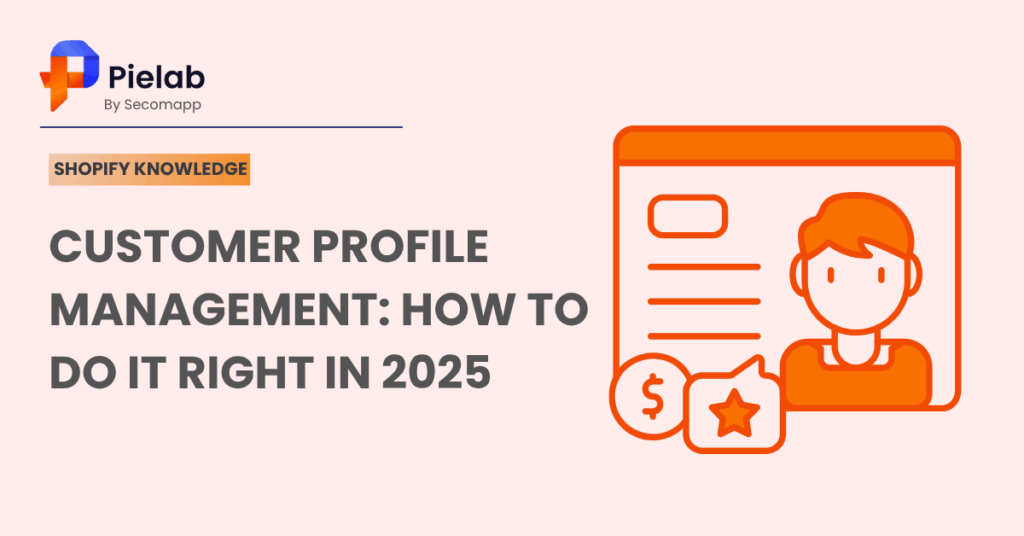What is customer profile management?
A customer profile is all the relevant information and data that you’ve captured for a customer, including the key interactions they have had with your brand. This includes both operational data and experiential data, such as:
- Demographic data with basic details such as age, location, job role, income etc.
- Psychographic data such as values, interests, attitudes, and personality traits
- Purchasing preferences and intent (goals, motivations)
- Pain points
- Buying behaviour and purchasing patterns
- Brand contact frequency
- Customer lifetime value
- Which communication channels they prefer to use
When what you have is an accurate customer profile, you are that much closer to tailoring your marketing strategies, products and services to better meet the specific needs of your audience. Managing this information in the right way leads to maximize your benefits.
Customer profile management is the process of gathering, organizing, and utilizing information about customers to understand them better and improve business interactions. This involves collecting data from various sources, creating detailed customer profiles, and using that information to personalize experiences, tailor marketing strategies, and enhance customer service.
Customer profile examples
To help you build out an in-depth customer profile, here is a customer profile example that gives you a good foundation to work with.
Here’s an example of a customer profile created on Qualtrics Experience iD:
With a dynamic customer profile, you can go into more depth for each experience.
Why is building customer profile management for business?
In the age of data-driven decision-making, businesses can no longer afford to treat customer information as fragmented or static. Customer profile management is the process of collecting, organizing, enriching, and activating customer data to build a complete, dynamic understanding of who your customers are and how to serve them better. It’s more than a CRM—it’s a strategic foundation for driving long-term growth, personalization, and loyalty.
1. Build a 360° View of Each Customer
Customers interact with your brand across multiple channels—your website, email, social media, support chats, and physical stores. Customer profile management consolidates these data points into a single, unified view. This comprehensive picture helps you go beyond basic demographics and understand the full context of each customer’s journey: their preferences, behaviors, challenges, and motivations. Instead of treating every user the same, you start recognizing them as individuals—each with their own story and needs.
2. Deliver Personalized Experiences That Convert
Today’s consumers expect more than one-size-fits-all content. They want brands to “get” them. A well-maintained customer profile allows you to personalize touchpoints—from product recommendations and promotions to website experiences and customer service responses. You can segment your audience based on interest, buying stage, or even sentiment, and then target them with the right message at the right time. Personalization built on rich customer data has been proven to increase engagement, conversion rates, and average order value.
3. Improve Customer Retention and Loyalty
Retaining existing customers is far more cost-effective than acquiring new ones. Customer profile management helps you track satisfaction trends, detect churn risks early, and respond with empathy. For example, if a customer has had repeated support issues, their profile will reflect this, allowing your team to offer proactive solutions instead of generic promotions. By continuously listening—both through direct feedback (like surveys) and indirect signals (like support chats or product usage)—you can build trust and foster long-term relationships that last beyond a single purchase.
4. Enhance Cross-Team Collaboration and Efficiency
When marketing, sales, customer service, and product teams all work from a single source of truth, you eliminate silos and improve alignment. A robust customer profile enables everyone to speak the same language about who your customers are and what they need. Instead of duplicating efforts or relying on guesswork, teams can collaborate with shared insights, streamline processes, and deliver consistent experiences across the customer journey.
5. Drive Smarter, More Strategic Business Decisions
Customer profiles aren’t just for engagement—they’re also critical for strategic planning. With access to real-time and historical data, businesses can identify behavior trends, anticipate product demand, uncover new market opportunities, and refine their pricing or positioning. You can analyze which segments are most valuable, where drop-offs occur, or how specific changes impact customer satisfaction. This kind of intelligence helps you prioritize what matters most and confidently steer your business forward.
How to Master Customer Profile Management and Build Real Connections
Managing customer profiles isn’t just about storing names and emails—it’s about understanding the full story behind every interaction. To truly maximize customer profile management, you need a thoughtful blend of feedback, behavioral insights, and the right technology. Here’s how to do it:
1. Gather Deeper Feedback—Both Direct and Indirect
Your current customers are your best source of insight. Don’t just rely on surface-level data—go deeper. Use feedback surveys, post-interaction polls, and even in-person interviews to capture how customers feel at each stage. Combine this with behavioral signals like support chats or drop-off points to build context beyond demographics. Every comment, star rating, or complaint tells part of the story.
2. Build Rich Profiles Based on Experience, Not Just Data Points
A complete customer profile should reflect not only what customers say but also what they don’t say. Use natural language understanding (NLU) tools to analyze unstructured data such as reviews, social posts, or chat logs. For instance, a customer might leave a neutral review but express deep frustration in a service conversation. By connecting these dots, you can avoid sending irrelevant offers and instead recommend smarter solutions.
3. Use the Right Tech to Bring It All Together
You can’t manage what you can’t see. Invest in a platform that centralizes and connects all types of data—from operational logs to emotional feedback. While many tools store basic customer data, look for those that also capture experiential signals to create a full, living profile. When done right, your sales, support, and marketing teams can engage customers with more relevance and less friction.
Final Thought
Maximizing customer profile management means going beyond generic fields and tapping into what customers actually experience. When you listen actively, track behavior intelligently, and act with empathy, your profiles become powerful tools for building loyalty, delivering better service, and driving long-term growth.

